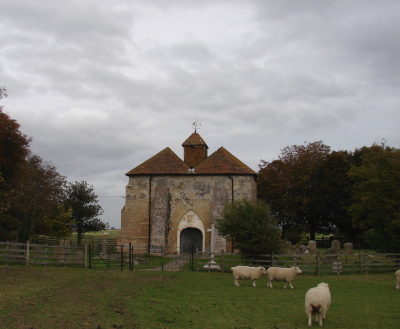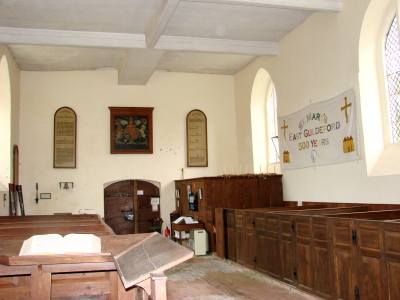East Guldeford – St Mary
A brick church, consecrated in 1505, it shows the influence of the Low Countries. It has been much altered, but retains good pre-Victorian fittings.
East Guldeford is the only marshland church in Sussex; East Guldeford level is technically part of Walland Marsh, not Romney Marsh, but the flat, wind-swept terrain is similar. The marsh appeared after the Western Rother was diverted westwards to Rye in a storm in 1287 (Millward and Robinson p173). It was gradually drained and passed into the possession of the Guldeford family, which was settled in Kent though taking their name from Guildford, Surrey. The marsh was then in the parish of Playden, but by the later C15 there was a sizeable settlement and in 1499 Sir Richard Guldeford (c1455-1506) received a faculty to build a church, consecrated in 1505 (1 p1).
The church is thus of one precisely dated build. Despite its breadth it has neither chancel nor aisles and there is on each side a shallow plinth topped by a moulded course, best seen to the north. Both north and south walls have three large windows and there is a single east one, but there is none at the west end, where there is simply a doorway with an elliptical head, set in a pointed and roll-moulded wall-arch. All have been altered and the simple intersecting tracery of the east and the south west windows is unlikely to be original; the straight mullions of the other windows are also clearly later, perhaps C18, possibly because the exterior of the church has suffered much from its exposed position.
Steer cites an earlier reference to ‘flowing tracery’ (ibid p2), which calls to mind the flamboyant tracery of the nearby chapel at Smallhythe, Kent, dated to 1516-17, whilst there is a comparable window at Brede. The last is of stone, but the use of brick at both Smallhythe and East Guldeford further confirms the well documented links with the Low Countries in this part of Kent and Sussex (the marshes may have been drained by experts from there), as does the unusual plan of East Guldeford, which recalls quite a few churches in Flanders of the same period. The tracery that survives or may be inferred at each of these churches is unlike any English work of the period, but the ruin of Midley church (which lies in Kent between Lydd and Old Romney on the main Romney Marsh) is rather different. It is built of brick, but two surviving openings have four-centred heads, which suggest both a late mediaeval date and the involvement of local craftsmen. Unfortunately the ruins are too scanty to allow more precise conclusions since the church had a short life and was abandoned in the C16.
The interior of East Guldeford church never had an arcade. Before renovations in 1764 there was a low-pitched leaded roof, possibly supported by a row of wooden posts down the centre of the church which the replacement of that year had certainly acquired by the C19 (see plate II in Steer) and may have had from the start. Horsfield (1 p502) describes the earlier arrangements, but is ambiguous on this point. The roof of 1764 has two hipped parts with a small bell-cote in the valley between. The Sharpe Collection drawing (1804) shows the windows as they are today, so they could also date from 1764. The side buttresses are original, but the east ones, built over the plinths and of larger bricks, are clearly C18, as are the triangular ones either side of the west doorway. Elsewhere, the walls themselves beneath the render show signs of repairs in larger bricks. They may have been done piecemeal, for the original brickwork has continued to decay, though recent repairs (see below) have interrupted this process.
The inside of East Guldeford church includes work of most periods since the early C16 and the fittings, plain whitewashed walls and mellow floor tiles look back to the pre-Victorian age, for no restoration is known. The roof is now a single span and the eastern part is differentiated only by pierced spandrels under the roofbeam. The posts in the centre of the nave were probably removed in the 1930s and the roof is now supported by hidden steel girders (VCH 9 p151). There is said to have been a further restoration in 1973-74 (Mitchell/Shell Guide p112), although repairs to the brickwork were in progress in 1980, using bricks of the original size (vidi). Further work in 2009 by Carden and Godfrey (responsible architect R Andrews) (Notice in church) included repairs and replacements to the brickwork of the north wall, though the cement render on the south side appears to have been untouched.
Although there are some houses around the church, the main centre of the parish is now at Camber.
Fittings
Boards: (West wall) C18 or early C19, displaying the Commandments, Creed and Lord’s Prayer.
Coat of arms: (North wall) Sir Richard Guldeford. Carved stone, with traces of paint.
Corbels: (East and side walls) Four early C16 ones, with angels holding shields. The lower two are damaged.
Font: Weathered, square, shallow bowl of Purbeck marble with arcading on two sides and rosettes on a third. It is late C12 and stands on a single modern pedestal of brick, though the underside of the bowl shows that there were originally corner-shafts. It is not known how it came to the church, as it is likely to be at least 300 years older.
Paintings:
1. (Above coat of arms) Poorly preserved early C16 heraldry.
2. (Around east end) Painted frieze of angels. The VCH rather optimistically suggests an ancient origin (ibid), but everything appears to date from around 1900. They were intended as part of a larger scheme, which was stopped by the then vicar (Langdon p210). No artist is known, though the colouring is delicate and they are of some quality, as well as having been well conserved. However, the level of drawing suggests a talented amateur who was well versed in contemporary artistic trends. There would have been no shortage of such people among the many artists in the Rye area.
Pews: Relatively low box-pews, probably early C19.
Piscina: (South wall) Depressed-head with a cut-back shelf, dating from the building of the church.
Pulpit: Plain two-decker, probably early C19.
Royal Arms: (Over west doorway) Painted panel, George IV.
Source
1. F W Steer: Guide to the Church of St Mary, East Guldeford, (Sussex Churches no 46), 1972




